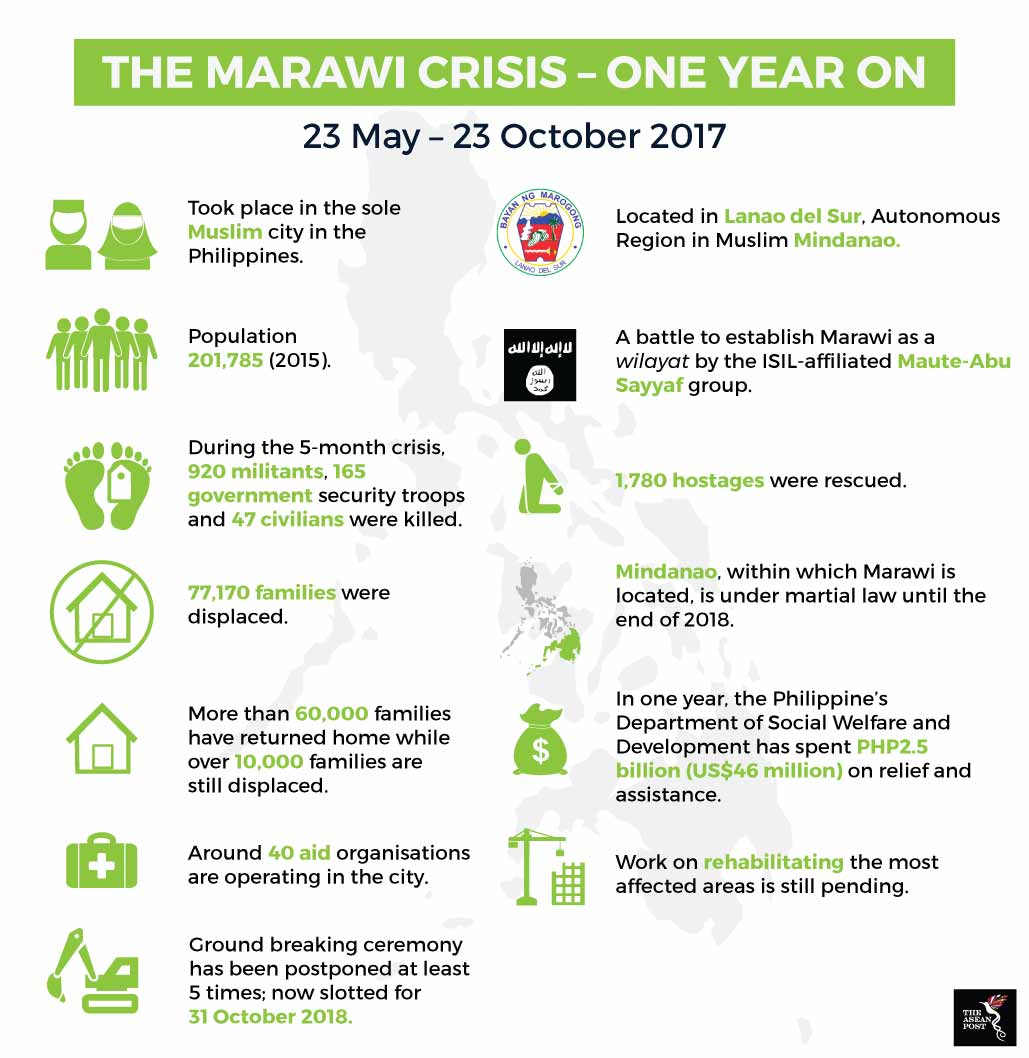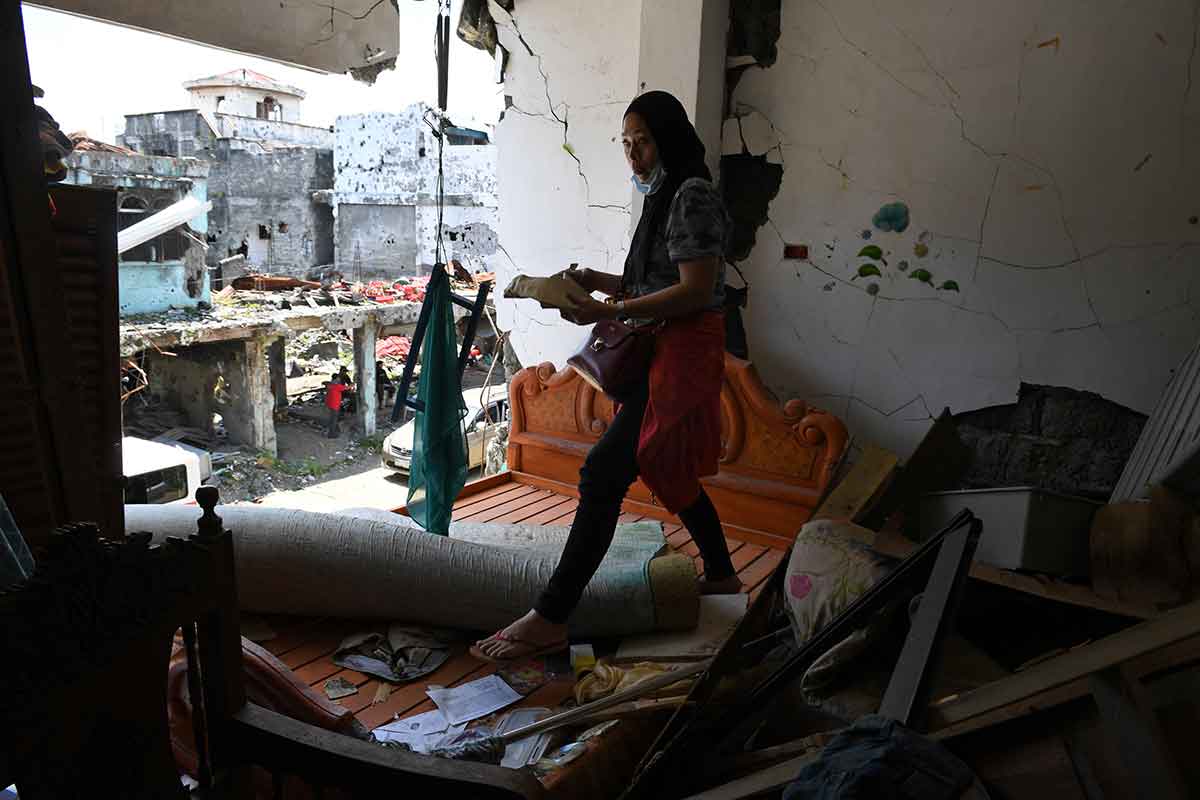The battle to establish Marawi as a wilayat or provincial territory by the ISIL-affiliated Maute-Abu Sayyaf group and the ensuing firefights to liberate the city by the Philippine government security forces was declared over by President Rodrigo Duterte, on 17 October, 2017.
The five-month conflict claimed the lives of 920 militants, 165 government security troops and 47 civilians, while 1,780 hostages were rescued during the crisis. Thousands of buildings were destroyed, with entire districts turned into rubble and ruins. A total of 77,170 families were displaced by the emergency. Mindanao, where Marawi is located, was placed under martial law that will remain in effect until the end of 2018; with the possibility of a further extension after two prior extensions by the Philippine Congress.
Overall, around 75,752 affected families have received more than PHP2.5 billion (US$46 million) worth of assistance from the Philippine Department of Social Welfare and Development (DSWD). More than 60,000 families have returned home while over 10,000 families are still displaced. Both groups require humanitarian assistance while the rebuilding and rehabilitation process goes on for the next few years.
Marawi is also receiving assistance from various intergovernmental and international non-governmental organisations (NGOs). According to the summary of ongoing and planned activities by the United Nations (UN) Office for the Coordination of Humanitarian Affairs (OCHA), around 40 organisations are operating in the city, working mostly on food security and livelihood, nutrition, protection, as well as water, sanitation and hygiene (WASH).

Source: Various sources.
Anyare?
For the residents of Marawi who have been kept away from their homes, including those located in the Most Affected Areas (MAA) for the past year, a return to normalcy could only start when they are free to go home. Hundreds of displaced residents tried to force the matter on the first anniversary of the city’s liberation by marching into Marawi but they were blocked by soldiers.
The MAA, located within an area of 250 hectares in the city of Marawi, is composed of 24 barangays (villages) and inhabited by around 11,000 families. The area and assets within its boundaries experienced total damage during the firefight between the terrorists and government forces.
Secretary General of rights group Bangsamoro National Movement for Peace, Drieza Abato Lininding, framed the displaced residents’ disappointment and confusion when he said that there were too many unanswered questions.
“One year ago, you said our Marawi was free. But we never felt the freedom. One year ago, you promised to rebuild our houses. But we still live in tents and shelters. One year ago, you said your plan was beautiful. Where is the plan?”, asked Drieza.
According to Eduardo del Rosario, head of Task Force Bangon Marawi (TFBM) - the entity responsible for Marawi’s reconstruction and rehabilitation - the displaced who have been waiting a year, would have to wait even longer as the ground breaking that will signal the kick-off for the reconstruction has been postponed yet again to the end of October. The kick-off has been postponed at least five times.
Leftover security issues
The response from the Deputy Commander of Task Force Ranao has indicated that the delays could be due to security issues. According to Army Colonel Romeo Brawner, the military stopped the residents returning home because of the dozens of unexploded ordnances still littering the district. Soldiers were also seen providing security to government workers surveying areas earmarked for rebuilding, some of whom have reported being harassed by impatient Marawi residents.
This include a 6-hectare area in the commercial district which was the main battle zone during the conflict. According to media reports, a local company, Finmat Corporation, is expected to undertake the PHP75 million (US$1.4 million) operation to clear war ruins and debris in the area. This will be followed by the construction of schools, barangay centres, a convention centre, a central market, parking areas and other structures. All work is expected to be completed by the end of 2021.
The repeated delays are said to have irked Duterte. But for the displaced, living in limbo in government-run shelters, prevents them from getting on with their lives. There is a call for community-driven rehabilitation for the affected people of Marawi, without which the future seems bleak for these victims of war.
Related articles:
Martial law in the Philippines: When will it end?
